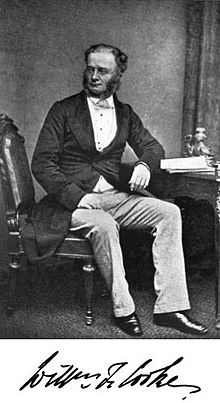William Fothergill Cooke
Sir William Fothergill Cooke (born May 4, 1806 in Ealing , England , † June 25, 1879 in Farnham , Surrey , England) was an English inventor who worked with Charles Wheatstone on the development of electrical telegraphy .
Life
His father, William Cooke († 1857) was since 1833 Lector of Medicine at the University of Durham. William Fothergill Cooke himself served in the military in India from 1826 to 1831. He then made wax anatomical specimens for his father. In 1833 he attended four anatomical lectures in Paris. In 1835 he accompanied his parents on a trip to Switzerland. In Heidelberg, Friedrich Tiedemann promised to help him. On the way back, he was back in Heidelberg in November and stayed in the brewery at the new Essighaus in Plöckstrasse . He had already made four boxes full of wax models. At the beginning of March 1836, John William Rizzo Hoppner reported to him from Georg Wilhelm Munkes (whom he later called Möncke ) lecture on Paul Ludwig Schilling from Cannstatt's telegraph.
After Cooke attended a demonstration on March 6, 1836 about the transmission of messages by wire , it occurred to him that something like this could be useful in the railway tunnels. He had such an apparatus made with three needles in Heidelberg and Frankfurt and traveled back to London on April 22, 1836. He visited Faraday twice and suggested a signal generator for the tunnel near Liverpool, but this did not materialize. On the advice of Peter Mark Roget , he turned to Charles Wheatstone on February 27, 1837 . Both decided to set up telegraph lines in England.
Their first joint patent from 1837 was impractical for reasons of cost. On July 25, 1837 (just two weeks before Schilling's death) they demonstrated their needle telegraph with five needles when she was a telegraph line along the railway line from Euston to Camden Town used to send a message to deliver successful and to receive a message.
On November 19, 1837, they signed a company contract , and on December 12, they filed a patent for their improvement with vertical placement of the needles.
In 1845 they patented the 1-needle telegraph. In 1845/46 he founded the Electric Telegraph Company with the businessman and chairman of the North Staffordshire Railway John Lewis Ricardo , of which he became director.
On November 11, 1869 he was promoted to Knight Bachelor .
Cooke is said to have had the two partners' better business acumen, while Wheatstone is credited with greater prominence in the history of the telegraph.
Cooke died impoverished and last until his death received an annual pension of 100 pounds .
literature
- Extracts from the private letters of the late Sir William Fothergill Cooke, 1836-39, relating to the invention and development of the electric telegraph: also, a memoir by Latimer Clark . Edited by FH Webb. Publisher: E. & FN Spon, London 1895 "The original letters are in the possession of the Institution of Electrical Engineers (late the Society of Telegraph Engineers)"
- HISTORICAL ACCOUNT OF THE INTRODUCTION OF THE GALVANIC AND ELECTRO-MAGNETIC Telegraph into England . BY DR. Joseph Hamel, Member of The Imperial Academy of Sciences at ST. Petersburg. Read before, and reprinted by permission of, THE SOCIETY OF ARTS, London. NOVEMBER, 1859. Printers: Lewis and Son, Swan Buildings, (49) Moorgate Street.
- Comments_thereon_by_William_Fothergill_Cooke Historical Account of the Introduction of the Galvanic and Electro-Magnetic Telegraph into England / Comments thereon by William Fothergill Cooke
Web links
- THE NEW YORK TIMES: Sir William F. Cooke (obituary, July 1, 1879)
- The Electric Telegraph Company, Central Station, Founders' Court, Lothbury, London
- Cooke, William Fothergill in: Dictionary of National Biography, 1885-1900, Volume 12, by James Burnley
- Biography of William Fothergill Cooke
- Archives Biographies: Sir William Fothergill Cooke 1806-1879 in: The Institution of Engineering and Technology
- 175th anniversary of the UK patent for Cooke and Wheatstone's commercially practical electric telegraph
Individual evidence
- ↑ Anton A. Huurdeman: The worldwide history of telecommunications , p 67. ISBN 978-0-471-20505-0 (English), retrieved 25 July 2011
- ^ Munro's Hero's of The Telegraph , pp. 216f
| personal data | |
|---|---|
| SURNAME | Cooke, William Fothergill |
| ALTERNATIVE NAMES | Cooke, Sir William Fothergill (full name) |
| BRIEF DESCRIPTION | English inventor, worked with Charles Wheatstone on the development of electrical telegraphy |
| DATE OF BIRTH | May 4, 1806 |
| PLACE OF BIRTH | Ealing , England |
| DATE OF DEATH | June 25, 1879 |
| Place of death | Farnham , Surrey , England |
